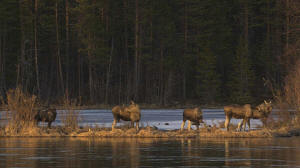Livestream of moose migrating to their summer pastures fascinates
millions across the globe
[April 15, 2025]
By STEFANIE DAZIO
Before Swedish slow TV hit “The Great Moose Migration” began airing
Tuesday, Ulla Malmgren stocked up on coffee and prepared meals so she
doesn't miss a moment of the 20-day, 24-hour event.
“Sleep? Forget it. I don’t sleep,” she said.
Malmgren, 62, isn't alone. The show, called “ Den stora älgvandringen ”
in Swedish, and sometimes translated as “The Great Elk Trek” in English,
began in 2019 with nearly a million people watching. In 2024, the
production hit 9 million viewers on SVT Play, the streaming platform for
national broadcaster SVT.
The livestream kicked off a week ahead of schedule due to warm weather
and early moose movement. Malmgren was ready.
From now until May 4, the livestream's remote cameras will capture
dozens of moose as they swim across the Ångerman River, some 300
kilometers (187 miles) northwest of Stockholm, in the annual spring
migration toward summer grazing pastures.
Not much happens for hours at a time, and fans say that's the beauty of
it.
“I feel relaxed, but at the same time I’m like, ‘Oh, there’s a moose.
Oh, what if there’s a moose? I can’t go to the toilet!’” said William
Garp Liljefors, 20, who has collected more than 150 moose plush toys
since 2020.
Slow TV success
“The Great Moose Migration" is part of a trend that began in 2009 with
Norwegian public broadcaster NRK's minute-by-minute airing of a
seven-hour train trip across the southern part of the country.

The slow TV style of programming has spread, with productions in the
United Kingdom, China and elsewhere. The central Dutch city of Utrecht,
for example, installed a “ fish doorbell ” on a river lock that lets
livestream viewers alert authorities to fish being held up as they
migrate to spawning grounds.
Annette Hill, a professor of media and communications at Jönköping
University in Sweden, said slow TV has roots in reality television but
lacks the staging and therefore feels more authentic for viewers. The
productions allow the audience to relax and watch the journey unfold.
“It became, in a strange way, gripping because nothing catastrophic is
happening, nothing spectacular is happening," she said. "But something
very beautiful is happening in that minute-by-minute moment.”
As an expert and a fan of “The Great Moose Migration,” Hill said the
livestream helps her slow down her day by following the natural rhythms
of spring.
“This is definitely a moment to have a calm, atmospheric setting in my
own home, and I really appreciate it,” she said.
Nature in your living room
The calming effect extends to the crew, according to Johan Erhag, SVT's
project manager for “The Great Moose Migration.”
“Everyone who works with it goes down in their normal stress,” he said.
The moose have walked the route for thousands of years, making it easy
for the crew to know where to lay some 20,000 meters (almost 12 miles)
of cable and position 26 remote cameras and seven night cameras. A drone
is also used.
[to top of second column]
|

This undated photo, issued by SVT, shows Moose in Junsele, Sweden
during preparations for the livestream 'The Great Moose Migration'
to document the annual Moose migration near Kullberg in northern
Sweden. (SVT via AP)
 The crew of up to 15 people works
out of SVT’s control room in Umeå, producing the show at a distance
to avoid interfering with the migration.
SVT won't say how much the production costs, but Erhag said it's
cheap when accounting for the 506 hours of footage aired last year.
Erhag said Swedes have always been fascinated by the roughly 300,000
moose roaming in their woods. The Scandinavian country's largest
animal is known as “King of the Forest.” A bull moose can reach 210
centimeters (6 feet 10 inches) at shoulder height and weigh 450
kilograms (992 pounds).
Despite their size, the herbivores are typically shy and solitary.
“We actually don’t see it very often. You often see it when you’re
out driving maybe once or twice in your life,” Erhag said. “I think
that’s one thing why it has been so, so popular. And then you bring
in the nature to everyone’s living room."
Hanna Sandberg, 36, first began watching the show in 2019, though
she didn't spot any moose. She tuned in the following year, finally
saw some and got hooked.
“You can watch them and be a part of their natural habitat in a way
that you could never be otherwise,” she said.
Moose mega-fans
After hours of showing an empty forest, a camera captures footage of
a moose approaching the riverbank. Suddenly, slow TV turns urgent.
The push alert hits SVT's app — “Första älgarna i bild!” which
translates to “First moose on camera!” — as viewers worldwide tune
in. The livestream's chat explodes as commenters type encouragement
for the animal, now making its way into the water.
”I would actually like to be a little fly on the wall in every
household that watches the moose migration. Because I think there is
about a million people saying about the same thing: ‘Go on! Yes, you
can do it!’" Malmgren said.
Mega-fans like Malmgren, who is in a Facebook group of 76,000-plus
viewers, are committed to watching as many hours as possible.

“I was late to school because I saw moose and my teacher was like,
‘What, you saw moose in the city?’ And I was like, ‘No, it’s on the
TV,’” Garp Liljefors said.
Malmgren said friends and family have learned not to bother her when
the moose are on the move.
“When someone asks me, ‘What are you doing? Oh, never mind, it’s the
great migration,’" she said. "They know.”
All contents © copyright 2025 Associated Press. All rights reserved |